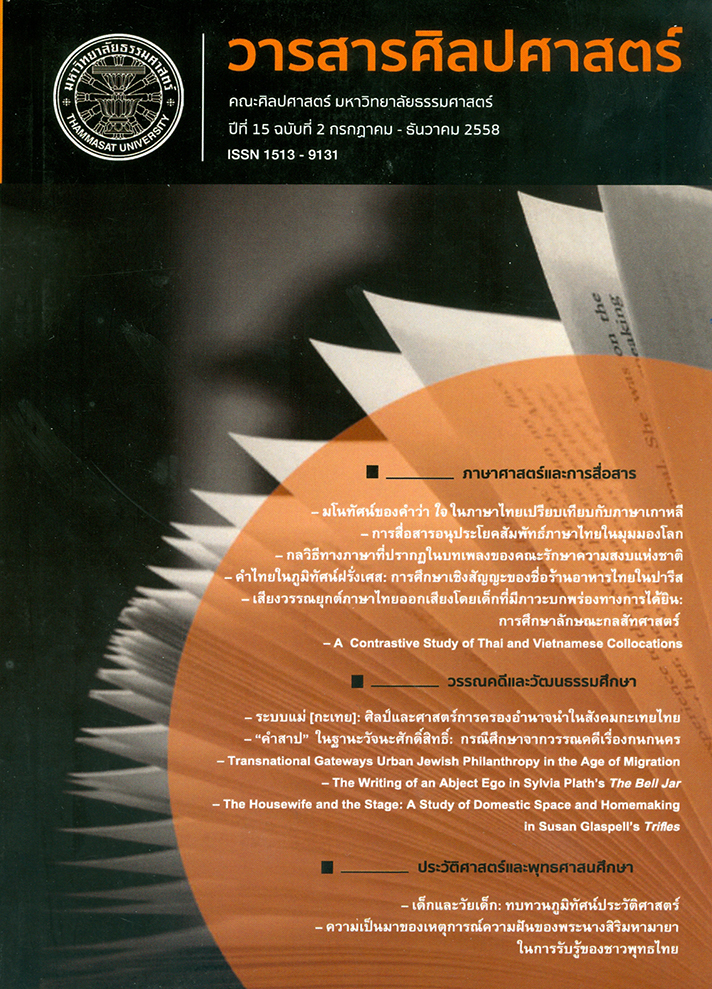The Writing of an Abject Ego in Sylvia Plath’s The Bell Jar
Main Article Content
บทคัดย่อ
The purpose of this article is to read Plath’s The Bell Jar with the post-Freudian psychoanalysis theory. Overall, the critics usually criticize this particular text on the aspect of gender and writing, such as the female language, or women and the socio-politics of the time the text is written. As a result, the individuality of the text and protagonist are repressed. That is, an individual character (person) is turned into a representation of female as a whole; and an individual woman a representation of society. However, when read against the post-Freudian psychoanalysis theories: Kristeva’s abjection and Lacan’s mirror stage, it could be seen that the motif of writing and characterization is too complicated to be limited by an imposed feminist stance of the text. The text presents an ego formation that is not typically seen. Instead of being formed from a whole image, the protagonist’s ego is formed from her identification with the abject, such as an image of a cadaver, blood, vomit, and suicide. Consequently, the ego preserves itself by way of self-erasure. Despite the fact that an abject ego is often associated with femininity, when it is considered by itself, it could be seen that the abject ego in this text does not follow the generalizing abject ego in feminist discourse. Furthermore, because The Bell Jar is a book written by the protagonist, the formation of the text and narrative is affected by the protagonist’s abject ego, not only dictated by the feminist discourse as most critics conceive. The result is a rather fragmented narrative with distorted time of storytelling. This shows that the theme of writing in “The Bell Jar” could be approached from other perspectives aside from feminist and psychoanalytic reading.
Keywords: Sylvia Plath, The Bell Jar, Feminism, Psychoanalysis, Writing, Abject
บทความนี้มีวัตถุประสงค์เพื่อวิพากษ์การอ่านและการวิจารณ์งานเขียนเรื่องเดอะเบลล์จาร์ของซิลเวียร์แพลท ผ่านการอ่านแบบจิตวิเคราะห์ประยุกต์ นักวิจารณ์ส่วนใหญ่จะให้ความสนใจประเด็นเรื่องผู้หญิงกับการเขียนในงานดังกล่าวเป็นหลัก ไม่ว่าจะเป็นเรื่องภาษาหญิงและชาย หรือการศึกษาสังคมของผู้หญิงในช่วงเวลาเดียวกันกับที่งานนั้นเขียนขึ้น ความเป็นปัจเจกของตัวละครจึงถูกกดทับ ทำให้อัตตะบุคคลกลายเป็นผู้หญิงของส่วนรวม หรือผู้หญิงที่เป็นปัจเจกกลายเป็นภาพเสนอของสังคมโดยรวม แต่เมื่อเราอ่านตัวบทดังกล่าวผ่านกรอบการอ่านแบบจิตวิเคราะห์ประยุกต์ โดยนำทฤษฎีว่าด้วยความอุจาด (Abject) ของคริสติวา และกระบวนการสร้างอัตตาในช่วงมิเรอร์สเตจของ ลาก็องมาใช้ร่วมกัน ทำให้เห็นได้ว่านอกจากตัวบทจะมีการนำเสนอมิติการสร้างตัวละครที่ซับซ้อนมากกว่าการอ่านแบบสตรีนิยมแล้ว ตัวบทยังนำเสนอกระบวนการสร้างอัตตาที่อยู่นอกเหนือการสร้างอัตตาแบบปกติด้วย แทนที่จะสร้างอัตตาผ่านการยึดติดกับภาพที่สมบูรณ์ตามทฤษฎีของลาก็อง อัตตาของตัวละครหลักถูกสร้างผ่านภาพความอุจาดไม่ว่าจะเป็นเลือด ภาพศพ และภาพการฆ่าตัวตาย อัตตาดังกล่าวจึงทั้งทำลายตัวเองและสร้างตัวเองตลอดเวลา ถึงแม้ว่าอัตตาอุจาดจะเป็นประเด็นที่โยงเข้ากับความเป็นหญิงตลอด แต่เมื่อเรามองที่ความอุจาดกับโครงสร้างอัตตาเพียงอย่างเดียว ก็เห็นได้ว่าอาจจะไม่ใช่อัตตาอุจจาดในวาทกรรมของสตรีนิยม นอกจากนี้ ตัวบทคือเรื่องที่ตัวละครเขียนขึ้น การเขียนที่พบในตัวบทจึงอาจได้รับอิทธิพลจากอัตตาอุจาดของตัวละครด้วย ไม่ใช่เพราะความเป็นหญิงอย่างที่นักวิจารณ์การอ่านส่วนใหญ่เสนอกัน แต่เป็นเพราะการเล่าเรื่องภายในที่มีลักษณะไม่เป็นเอกภาพ มีการกระโดดไปมาของเวลาอยู่ตลอด ไม่เดินเป็นเส้นตรง ด้วยเหตุนี้จึงทำให้เห็นว่าประเด็นเรื่องการเขียนของเดอะเบลล์จาร์สามารถอ่านได้อีกหลายรูปแบบ ไม่จำเป็นต้องผูกมัดกับความเป็นสตรีหรือแม้กระทั่งจิตวิเคราะห์เพียงอย่างเดียว
คำสำคัญ ซิลเวียร์ แพลท เดอะเบลล์จาร์ สตรีนิยม จิตวิเคราะห์ การเขียนความอุจาด


